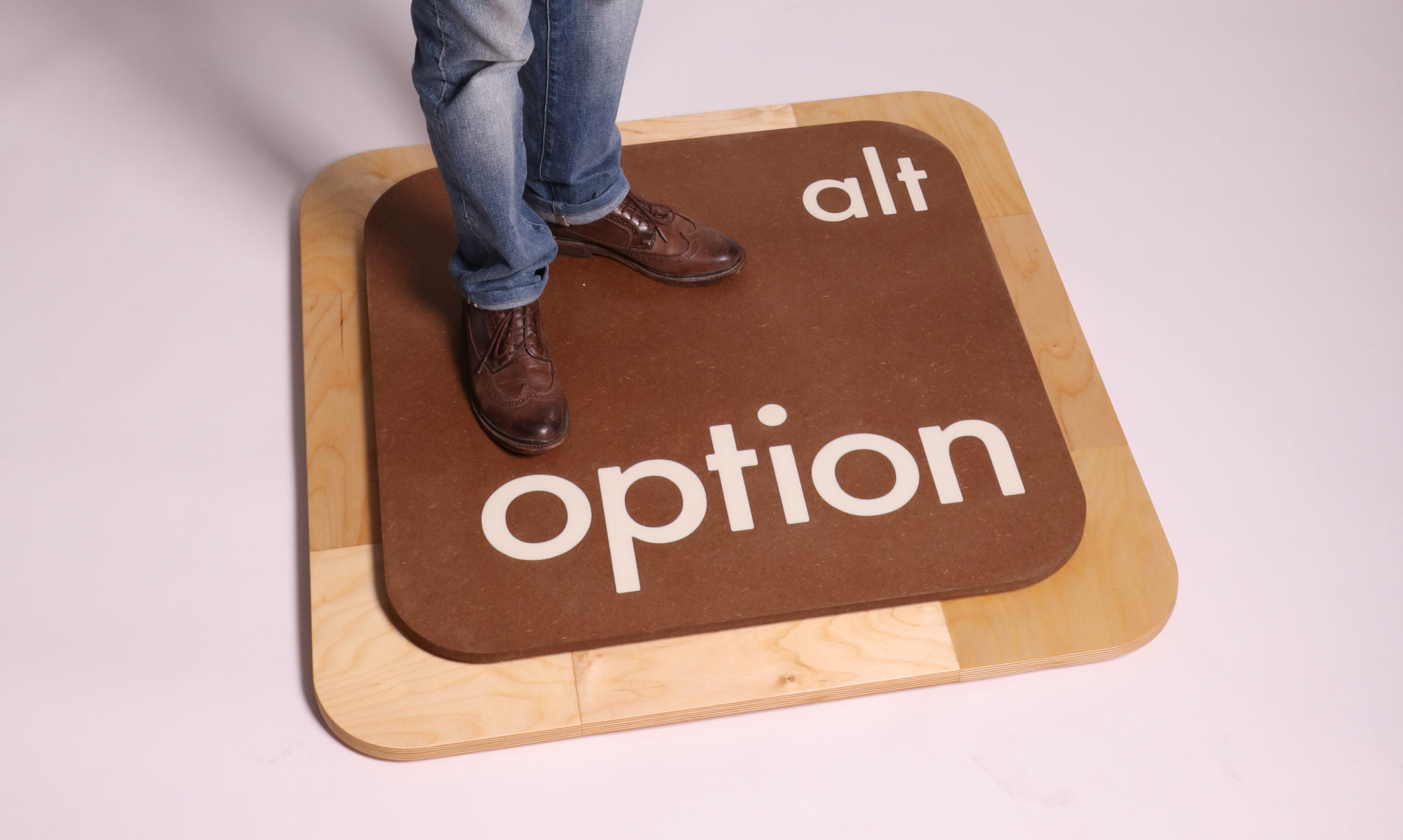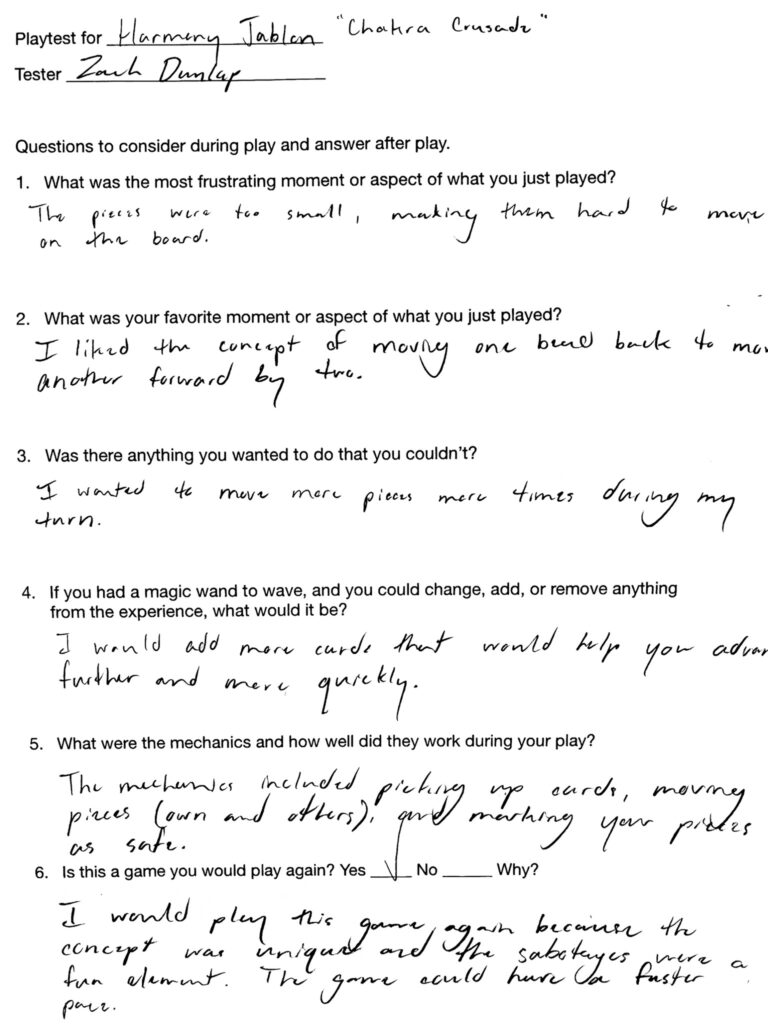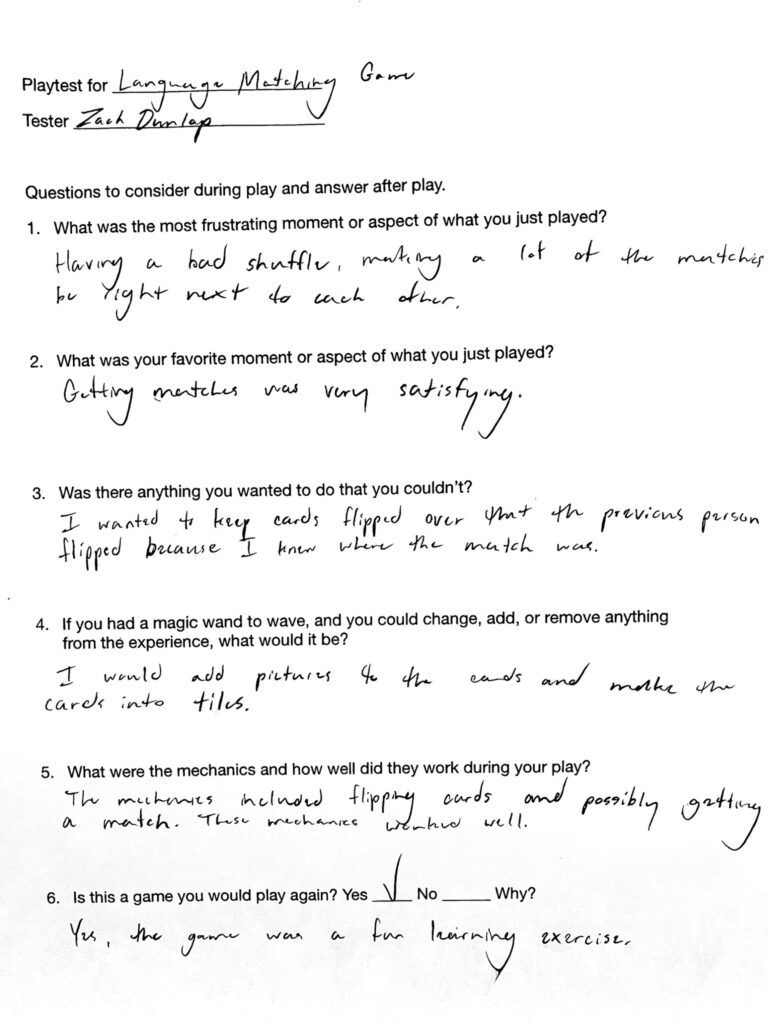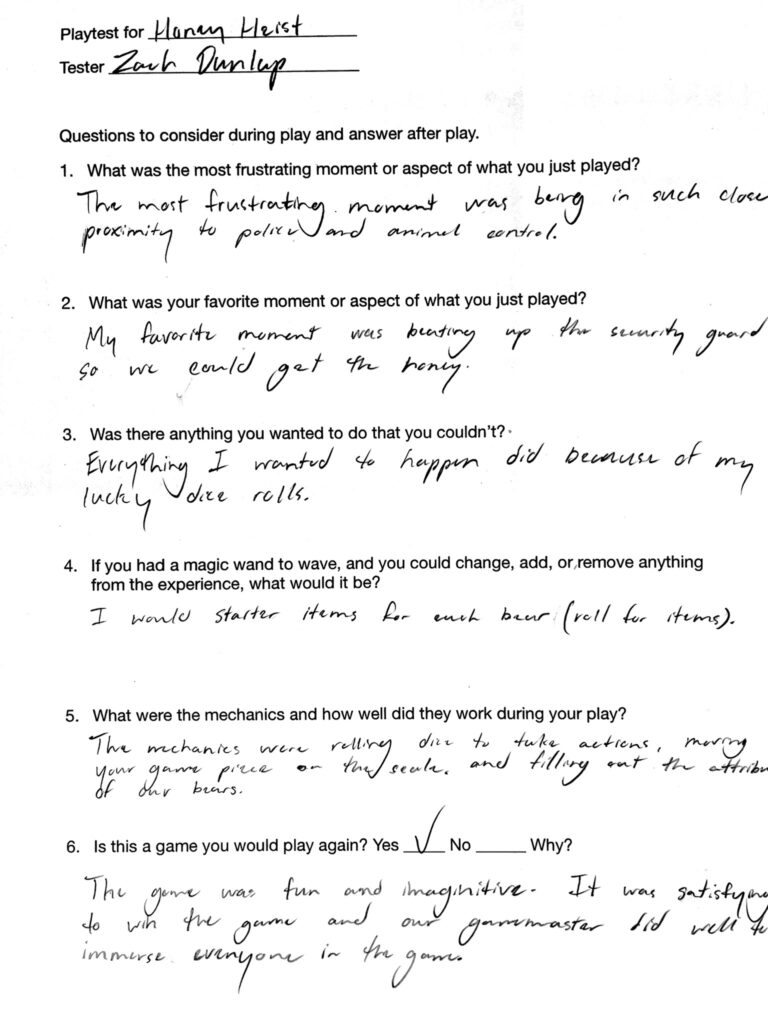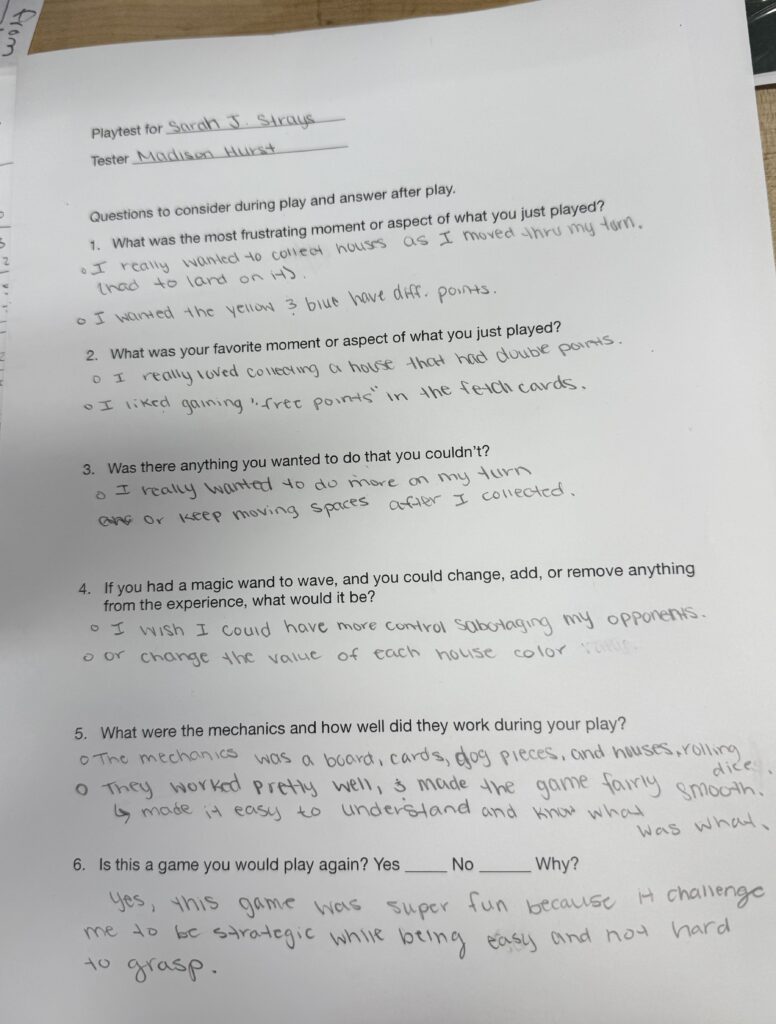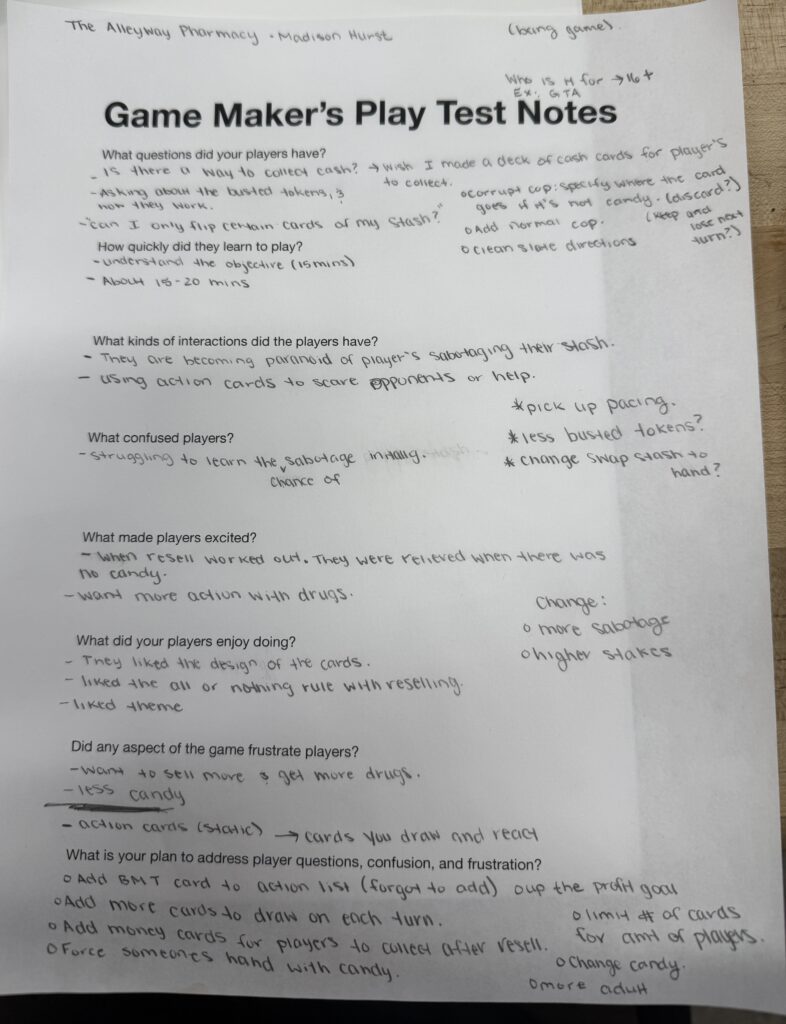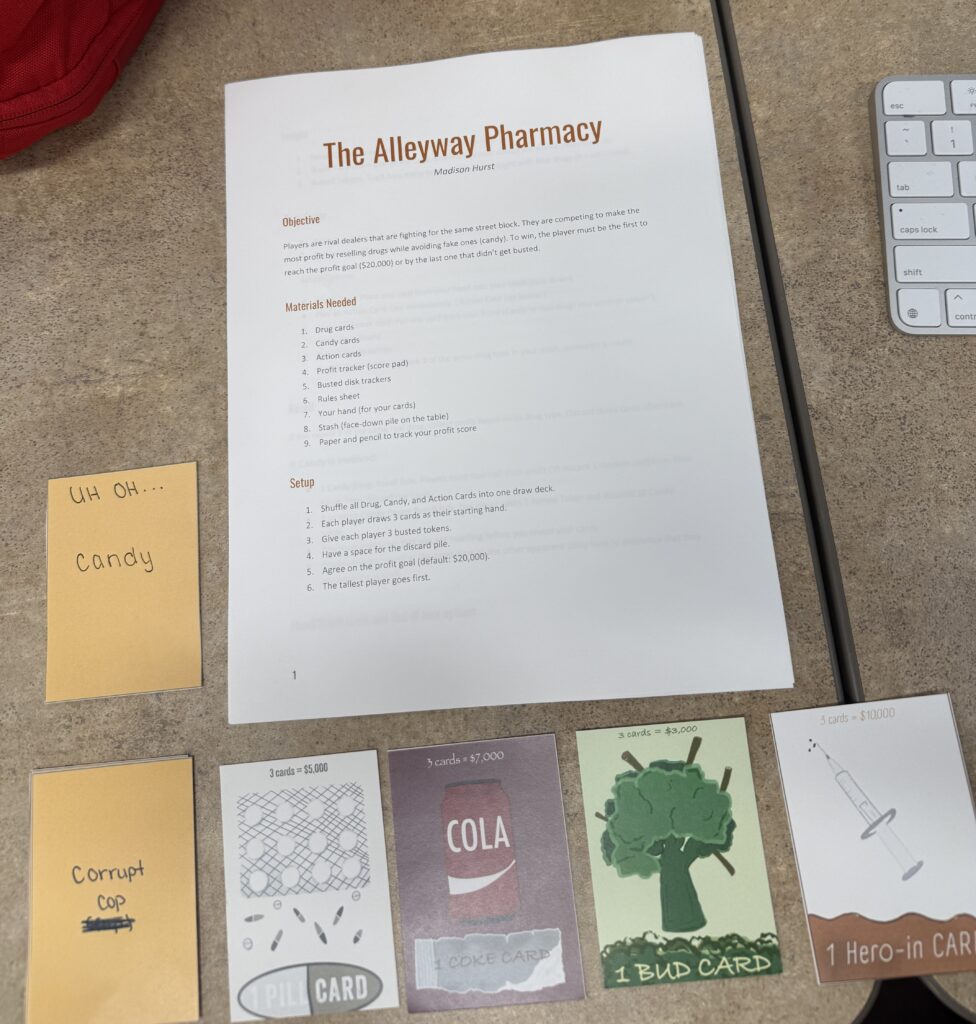- Question Set 1
- what is the difference between a game designer and a game developer? A designer generally creates and actually designs the original game concept and prototypes. Developers take those designs and make them better. They test them and improve them over many iterations and ultimately finish the game.
- what commonly occurs during the game development process? Tweaking rules and concepts within games to make them better and more cohesive.
- what are the challenges of balancing a game? Primarily, “Numbers” and the cost of making decisions. The detailed challenges stem from these things but these are the overarching categories. Basically, controlling and balancing “imbalance” without completely eliminating it.
- what should every player of your game believe? why? (I couldn’t directly find it in the readings) but they should believe that your mechanics of the game will work and it is possible to win – i think having a believable metaphor is also very important so the players are immersed in the environment
- how can you avoid stealing players fun? Well there are quite a few ways, but it basically comes down to not making it complex and eliminating extra confusing stuff.
- what 10 maxims should you follow when writing rules? No intermediary words, use real words, make no more words than necessary, add flavor (but not too much), make your text no smarter than the reader, discard rules that can’t be written, take a breath, go easy on the eyes, get your final version, fix it in the FAQs
- Question Set 2
- how has play testing changed your game? it exposes flaws and fine tunes rules
- who from class would you like to play test your next game or version 2 of your first game? Well if it is version two, I would like at least two people who played it first (like Harmony or Zach or Maria) and at least two other new ones. I think same for my new game honestly – I think Brice also gives honest and constructive advice
- who is the audience for your game? well the game i have for this week is probably for older kids who understand card games to adults of any age
- who should play test your game outside of class? mmmm, I guess I might give it to some of my friends to play. I’d also like to see how my family would react to it with a wide range of ages and types of gamers.
Week 8: Question Set 2
- Play testing my game taught me not to be too invested in how I believe the game should be played. I had the thought to force players to act a certain way, and was slightly frustrated when reality did not match my expectations. With this, I learned to give my players more leeway, especially when just starting the game. I believe I created a nicer, more player friendly, rule set because of the feedback from my first play test.
- I’d like to replay my game with the same play testers as last time, so that I can gather their thoughts on the differences that they noticed. But I am also able to play test with new players, so I can get different perspectives on the core game play, as well as the changed rules.
- My initial target audience was fast-paced card players. I enjoy cards, and games where speed is integral, so I wanted to create a game that blends the two together. Creating this game taught me that many players are unfamiliar with cards, which meant that I had to change my game to accommodate.
- I would like to play test the game with my friends outside of class. As card players, I feel like they would be not only more excited to play, but also more familiar with the process of drawing cards, understanding sets/runs, and betting on their hand.
Week 8: Reading Question Set 1
- According to Kobold’s Guide to Board Game Design the author states that the difference between game developers and game designers are their positions in the process of a game’s creation, from inception to release. Game designers create the skeleton of the game: the theme, mechanics, game play, and initial rules of the game. Upon finishing a working draft, developers then take the game and polish it to make the game more inciting to publishers and players alike. Dale Wu, and Mike Selinker, in their review of Dominion’s mechanics and development, equated designers to book authors and developers to editors who make suggestions and revisions before the publisher.
- Using Dominion’s development as inspiration, Selinker mentions four key events that occur in game development: Initial play testing, rule setting/refining, blind play testing, and theming/titling. In the initial play test, the designers ensure that the game is playable, and lacks key flaws missed during development. Rule setting is when the rules are drafted that better interact with the mechanics. Blind testing is putting the game in front of new players to test whether they can understand the game’s mechanics and uncover any oversights. Titling and theming is developing the core metaphor or theme that the game is based around. These events to not always happen in the same order. The theming can come before the play test, and the blind test can come before key rules are developed.
3. Two key challenges that Paul Peterson mentions in game balancing is accounting for every combination of actions, and understanding the cost of each action. A large challenge in game design is ensuring that every action is balanced around so that a sequence of actions or cards, does not create an unfair situation. Doing this is time-intensive and difficult with more complex games. The solution is to test the most unfair combinations. Another challenge in game design is balancing around the cost of an action, like playing a card or taking an action. All games have an inherent cost, and I associate with risk. If the cost of an action is not justifiably high or low, actions will feel overpowered or under powered. Peterson’s solution was to lean into the imbalance, but develop around it.
4. Every player in the game should believe that they have an equal chance to win. Dave Howell cites this as one of the most important principles of game design. Without the belief, even a small one, that any and all players can win, players will psychological divest themselves from the game and become apathetic to the outcome. In short, players must feel like they can win up until the end, because if they don’t they can become apathetic.
5. There are many things designers can do to avoid stealing players’ fun. Many of them involve how players interact with each other, rather than how players interact with the game. One of these things is avoiding “Kingmaking” (allowing players to choose winners), because “Kingmaking” leaves the fate of the game to the players, which often relies on chance and not skill. Games should also not reward winners and punish losers too much, as they create situations where momentum keeps players ahead or behind. They also create situations where hopeless players grow apathetic.
6. The ten maxims Mike Selinker mentions(along with my interpretations) are:
- Use no intermediary terminology: “Call things what they are.”
- Use real words: “Make your rules understandable from the get-go, and ensure that they are consistent”
- Make no more work than necessary: “Do not over complicate core processes of the game”
- Add flavor (but not too much): “Understand how much flavor your game needs”
- Make your text no smarter than your reader: “Do not obfuscate rules”
- Discard rules that cannot be written: “If a rule is too complex to understand (or even write), remove it or alter it.
- Take a breath: “Break your text up if it is getting to long”
- Go easy on the eyes: “Make your rules readable”
- Playtest your final version: “Review your rules in a final play test to fully understand their interpretations.”
- Fix it in the FAQ: “Make subsequent clarifications later (do not ignore them).”
Playtest Questions: ESPN Fantasy Football
Playtest Questions: Chakra Crusade, Language Matching Game, Power, Honey Heist
10/16 Questions
Strays Play Test Review
Alleyway Pharmacy Play Test Review
Game Idea for Prototype 2/Questions set 1 and 2
Rules for Chakra Crusade
Strays – Play-test
- One frustrating aspect of the game was the lack of a specified win-state. More clarity on how the game ends would allow more strategies to form. However, we were playing on a time-limit, so that could have affected how the game was played. Another frustrating aspect of the game were the start points. Your spawn depends on the dog you choose, so some players may end up clumped together while others will be separated. One problem I saw though were the lack of specific directions. For example, a card stating “Go back 2 spaces” is confusing because there is no sense of “forward” and “back”.
- I enjoyed the art of the game. I liked the “open-world” aspect of the game, where you can choose to go anywhere. I also liked the chance aspect of the cards you drew, which added a lot of world building to the game.
- I would have liked a better way to track point. Some of the cards force players to give up, or swap, houses (and their point values). The problem began when players forgot which house came from an alley or a road. This is important because points are doubled if houses come from the alley. I would either remove the “double points” rule, color the alleyway houses differently, or create a new way for players to track their houses.
- I would clarify some of the rules in the game. We always discarded cards after we drew them. However, cards often had lasting affects that we were unaware of, or worked retroactively. A rule that clarified that we should collect the cards we draw would clear some of the confusion. I would also add a way to force a direction for players.
- I enjoyed this relaxed style of board game. There were many moments of fun conflict between players because of the competition the cards forced.
- I would play Strays again. I really liked the theme of the game, and the idea of scouring the neighborhood to collect loyal followers (households). Our group got very territorial, which was the hidden intent of the game.
The Alleyway Pharmacy – Play-test
- Two frustrating aspects of the game was the slow pace and lack of player interactions. Even though players understood the game fundamentals, the game play often revolved around players deciding which action to take (and trying to figure out what each action did). I would commit to the idea of writing action descriptions on the cards themselves, and not coloring them so that they do not stand out. Another aspect of game play was the lack of sabotage. It did not feel like my actions affected other players very much. Moreover, the game was not very punishing.
- I loved the theme and irony of drug dealers selling food and being caught for selling candy. It was a creative theme, and I enjoyed seeing the subtle jokes each card had. I also enjoyed the hand and stash mechanic. It added a complex layer the game, where players must make commitments to selling their product and cannot undo their decision, allowing other players to pass candy into their stash.
- I wish for more opportunities to affect my opponents. While Steal, Snitch, and cards of that category did spice the game up slightly, I felt as though they had little to no affect on the game.
- I would make the card count depend on the number of players in the game.
- I really liked the layers of game play in The Alleyway Pharmacy. Players have a hand that they can view, and a stash that they cannot. Players must make the choice to risk being sabotaged when they decide to stash and sell their product.
- Yes. I would play The Alleyway Pharmacy again, with some tweaks, it could become a great well-rounded competitive game.
Deadline – Play test (Version 1)
- One frustrating aspect of the game was the lack of control over what cards were taken.
- I enjoyed collecting cards from others and getting a lucky break during a round. The high-risk, high-reward style of game play made the game easy to learn but difficult to master.
- I wished for more ways to affect my play. Discarding jokers is near impossible, almost always locking you into a situation where you lose points.
- I would tweak, or at least, reevaluate the way that points are calculated. Players are almost always trying for high cards (Jacks, Queens, Kings, etc.). Though this inherently makes getting runs/sets of high cards more dangerous, it does not balance out against the low value of the lowest cards. Three 2s will almost always be the worst hand to hold on to. I would balance some of the lower cards to keep up with higher sets/runs.
- I thought that mechanics were well designed. Rounds flowed into each other and the game play sped up as we understood the game more.
- I would really like to play Deadline again. As a person who enjoys card games, I think it blends a simple concept, a nice theme, and a high skill ceiling very well.
Tale Weavers – Play test (Version 1)
- One frustrating aspect of the game was trying to work within the strict scope of the cards provided. Many of them are extremely specific, meaning one must work really hard to spin the story of the card together. There were many instances of players changing the prompt so that the story fits better.
- Two events stuck out to me during game play. Reading the card prompts is quite funny, they’re witty and employ a dark or ironic style of humor. Many of the stories people created on the fly were very funny.
- I wanted a rule, similar to a house rule in Cards Against Humanity, where players can discard their entire hand and collect new cards to better match the prompt. It felt like my cards rarely aligned with the prompt.
- As mentioned before, I would remove some of the specific wording in some of the cards, and make them more vague.
- The mechanics are well thought out. Though I often struggled to flow my story cards together with the settings and characters, when they did align it made an incredible story.
- I would play this game again. It would make a nice party game for large groups of adults.
Broken Mime – Play test (Version 1)
- The most frustrating actions in Broken Mime was the inability to repeat actions done. Though the intent of this restriction is reasonable, it makes cards that depict specific actions difficult to re-enact.
- The charade’s style game play of Broken Mime lent to many funny moments. I also enjoyed the debate that happened after the card’s prompt was revealed.
- As mentioned before, some cards were incredibly specific, so it made not repeating actions difficult.
- I would add more clarity to some of the rules. For example, are players besides the participating two supposed to watch or look away?
- The charades mechanics work with the concept of Telephone well. Rounds often ended with hilarious debates of what the original card was.
